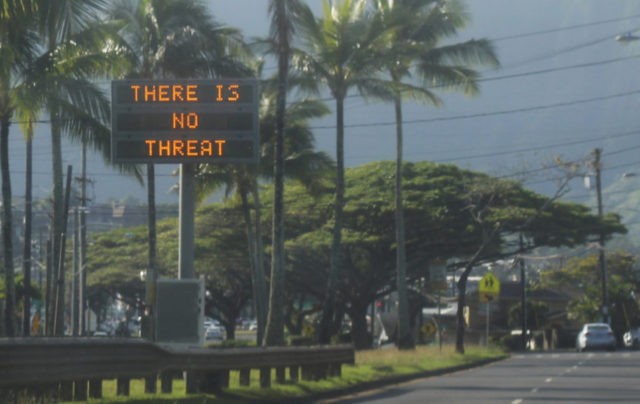The Federal Communications Commission (FCC) announced on Tuesday that flaws in Hawaii’s emergency alert system and a confused employee caused the false alert warning that a nuclear ballistic missile was closing in on the Hawaiian Islands.
On the same day as the transcript of the FCC’s open meeting into the matter was released, a local media report picked up by the Associated Press said that the employee who sent the false alert had a troubled past and had been fired. The administrator of the Hawaii Emergency Management Agency (HI-EMA) also reportedly stepped down.
Worker who sent mistaken missile alert in Hawaii has been fired; had performance issues in the past. https://t.co/c82TUaCc34
— The Associated Press (@AP) January 30, 2018
The Honolulu Star Advertiser reported on Monday:
Gov. David Ige and Hawaii Emergency Management Agency officials announced that HI-EMA administrator Vern Miyagi resigned this morning and the so-called “button pusher” has been terminated as a result of the state’s internal investigation of the Jan. 13 false alert of an imminent missile attack.
“Gen. Miyagi, a respected military leader, and honorable man has taken full responsibility and submitted letter of resignation today,” state Adjutant General Maj. Gen. Joe Logan, who ordered the investigation, said today at a news conference inside Diamond Head, HI-EMA’s headquarters.
As a result of the findings, Logan said, the worker who set off the alert was fired on Friday, another HI-EMA executive resigned after Jan. 13, and a third employee is being suspended without pay. The fired worker had been on paid leave after the false alarm.
Retired Brig. Gen. Bruce Oliveira, who headed the internal investigation into HI-EMA, said the button pusher failed to hear “Exercise, Exercise, Exercise” although five others got it right.
The Star Advertiser reported the fired employee has been under scrutiny for ten years and had twice before been confused about drills versus a real attack on other occasions.
The FCC announced its findings into the matter, although without publishing their final report.
“Based on our investigation to date, the Bureau believes that a combination of human error and inadequate safeguards contributed to this false alert,” James Wiley, attorney advisor for cybersecurity and communications for the FCC reliability division, said at an opening meeting.
“With respect to human error, due to a miscommunication between the midnight shift supervisor and day shift supervisor, the drill was run without sufficient supervision,” Wiley said. “In speaking with the bureau, other emergency management agencies stressed the importance of proper drill supervision, and that conducting a drill without proper supervision would not be tolerated.”
“Further, the midnight shift supervisor initiated the drill by playing a recording that deviated from the script of the agency’s established drill procedure and included the phrase, ‘This is not a drill,’” Wiley said.
“And finally, the warning officer at the alert origination terminal apparently failed to recognize that this was an exercise even though the other warning officers on duty understood that this was not a real emergency,” Wiley said.
At the time of the false alert, FCC Chairman Ajit Pai called it “unacceptable” and announced that an initial investigation found that state officials did not have adequate procedures in place to avoid a mistaken warning or to reverse that warning.
“Pai said Tuesday that after the bureau issues its final report, the FCC will work with officials across the country to determine whether the agency needs to intervene,” the Hill reported.
“The public needs to be able to trust that when the government issues an emergency alert, it is indeed a credible alert,” Pai said. “Otherwise, people won’t take alerts seriously and respond appropriately when a real emergency strikes and lives are on the line.”

COMMENTS
Please let us know if you're having issues with commenting.